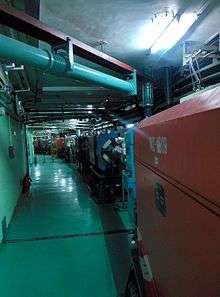Beijing Electron–Positron Collider II

The Beijing Electron–Positron Collider II (BEPC II) is a Chinese electron–positron collider, a type of particle accelerator, located in Beijing, People's Republic of China. It has been in operation since 2008 and has a circumference of 240.4 m.[1]
It was intended as a charm factory and continues the role CLEO-c detector. The center of mass energy can go up to 4.6 GeV with a design luminosity of 1033 cm−2·s−1.[2] Operations began in summer 2008 and the machine has run at multiple energies.
BES III
The BES III (Beijing Spectrometer III) is the main detector[3] for the upgraded BEPC II.
BES III uses a large superconducting solenoid to provide a 1-tesla magnetic field, and also features a helium gas-based tracking chamber and an electromagnetic calorimeter using 6240 caesium iodide crystals.
See also
References
- ↑ "Beijing Electron Positron Collider (BEPC)". Institute of High Energy Physics Chinese Academy of Sciences. 2004-01-09. Retrieved 2015-10-15.
- ↑ BESIII Collaboration (17 Aug 2009). "Charm Factories: Present and Future". AIP Conf. Proc. 1182: 406–409. arXiv:0908.2157
 . doi:10.1063/1.3293832.
. doi:10.1063/1.3293832. - ↑ Minnesota BES-III home page